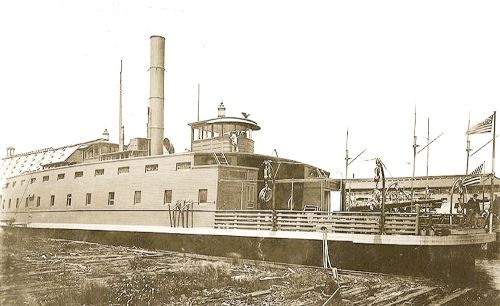


At Port Royal GOVERNOR ROYAL had to be drydocked to allow for
extensive repairs to be made to the vessel. Food remained an issue, as
the provisions stored on board had spoiled further. At Port Royal, naval
officers at the navy yard took up a collection of food for the ship's
crew, but the officers of the GOVERNOR RUSSELL did not allow for the men
to accept the collection. Also at Port Royal the decision was made
to give up on getting the ship to Cuba, and, instead, to
return to New York
After a month, on September 7, the vessel was able to depart to return to New York City. Unfortunately she was battered by another storm. The ship took on 17-1/2 inches of water per hour and the ship's electrical plants failed repeatedly. Portions of the "forward overhand" had to be cut away supposedly to save the vessel. The ship had to put in at Hampton Roads, Virginia for repairs, arriving stern-first and with water at a depth of seventeen feet in areas of the vessel. She arrived at the Norfolk Navy Yard on September 13. Instead of being repaired, the U.S. Navy declared the ship unfit for duty on September 28, 1898. The ship was removed from the Navy's roll on July 3, 1899.
ADVANTAGES/DISADVANTAGES:
This vessel was designed for use in river crossings and was not built to withstand the ravages of the open ocean. The folly using the vessel at sea was rapidly discovered as she was so damaged by storms at sea that she was declared unfit for service.
| Classification: | Auxiliary Gunboat | |
|---|---|---|
| Launched: | May 11, 1898 | |
| Commissioned: | June 24, 1898 | |
| Armament: | 0ne 3-inch breechloading rifle | |
| Four 3-pounder Hotchkiss guns | ||
| Contractor: | William McKie | |
| Length: | 157 feet | |
| Beam: | 57 feet | |
| Draft: | 9 feet, 4 inches | |
| Gross Tonnage | 713 tons | |
| Net Tonnage | 485 tons | |
| Complement: | Crew of 6 officers and 60 enlisted men under the command of Lt. Charles Grant | |
| Speed | 9 knots |
|
| Bunker Capacity | 150 tons | |
| Engine Type: | Double compound engines, generating 500 hp. |
Clerk of the Joint Committee on Printing, The Abridgement of the
Message from the President of the United States to the Two Houses of
Congress, Vol. 2, Washington DC: Government Printing Office, 1899,
1228-1229.
"Crew is Mustered Out," Boston Evening Transcript (Boston,
Massachusetts). September 30, 1898, 8.
Naval History Division, Department of the Navy, Dictionary of American Naval Fighting Ships, Vol. III, Washington DC: Government Printing Office, 1968, Reprinted 1977, 126.
Report of the Chief of the Bureau of Navigation. (Washington: Government Printing Office, 1898) 23.
"Starts for Cuba Tomorrow," Boston Evening Transcript (Boston
Massachusetts). July 15, 1898, 7.
..